Lecture
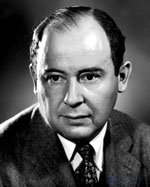 John von neumann
John von neumann
At the end of 1944, when Mauchly and Eckert worked on a computer with the stored EDVAC program, six months after Eckert came up with the idea of a computer with a stored program, they were joined as a consultant by John von Neumann. At that time he was 41 years old, and he was known as a brilliant mathematician. He was destined to have a significant impact on the development of computer technology in recent years, to identify the main postulates that determine the architecture of a computer (known as the von Neumann postulates).
John von Neumann was born in Budapest on December 28, 1903. He was a native of the Hungarian upper class, from which many giants of mathematics and physics emerged. His father, Jewish banker Max Neyman, deserved sufficient Habsburg respect to add the honorary “Margattai” to his family name (later changed by John to “background”). Janosh, as he was called in his childhood, was the eldest of three sons.
As a young child, Janos loved mathematics and constantly sought to adapt its logic to the world as a whole. Long walks with a childhood friend Eugene Wigner led them to a discussion about set theory and number theory. However, his immense intelligence was not limited to mathematics. From the age of six, he joked with his father in classical Greek. When he was 10 years old, a personal tutor was hired for the boy, later the teacher suggested his father to develop the special talents of János. The young man was forced to rotate in the circle of his peers, so as not to seem arrogant. He did not need care. His extraordinary mind was respected. From 1911 to 1916 he attended the Lutheran gymnasium in Budapest and was her best mathematician.
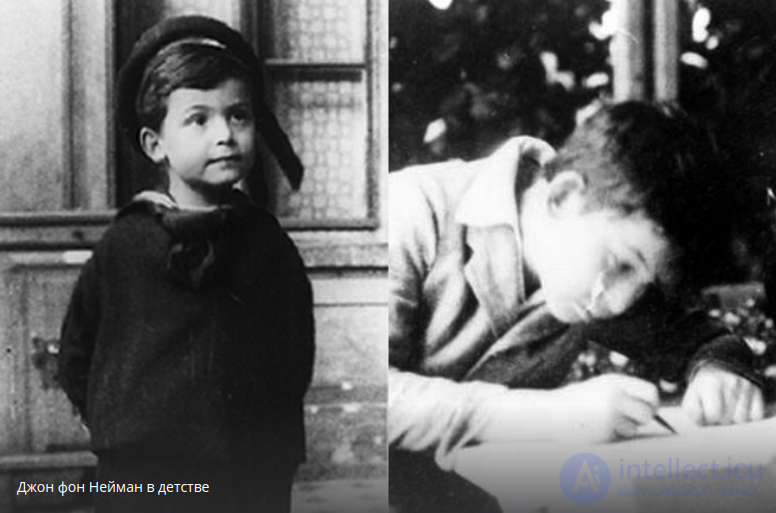
The riots of the First World War struck the family von Neumann. When the communist regime of Bela Kun came to power in 1919, the banks were expropriated, leaving Max von Neumann one choice - to run with his family to their home in Vienna. They stayed there for 4 months, returned home in August 1919, two months after Kuhn’s fall. This episode turned Janosh into an anti-communist for life.
Although he was enrolled in a university in Budapest in 1921, von Neumann received most of his education at other institutes. Much of the time, especially from 1921 to 1923, he spent at the University of Berlin. There he could study with the mathematician Erhard Schmidt and listen to the lectures of Albert Einstein. Von Neumann continued his studies at the Swiss Federal Institute of Technology in Zurich, where he received a diploma in chemical engineering in 1925. A year later, on March 12, 1926, at the age of 22, he received a doctorate in mathematics from a university in Budapest. Non-profiling subjects he had experimental physics and chemistry. While studying at the university in Göttingen in 1926 and 1927, von Neumann communicated with some of the most magnificent minds of mathematics. There he became friends with student Robert Oppenheimer.
From 1927 to 1930, von Neumann was a lecturer in mathematics at the university in Berlin. It’s rare for a young person to receive such a position. During the first year he published 5 scientific papers there. Three of them, which set forth the mathematical structure for quantum theory, were of great importance for this field of science. The fourth scientific work was the first attempt to study game theory. The fifth considered the relationship between formal logical systems of the limits of mathematics. By the 30s of the 20th century, von Neumann was recognized as one of the leading mathematicians in the world.
He spent the spring of 1929 in Hamburg and it was then that he received an invitation to give lectures at Princeton University, which was a turning point in his career. Von Neumann came to the United States in 1930. After giving lectures on quantum statistics for a year at Princeton, in 1931 he was appointed to the post of professor. Mathematical hydrodynamics was the subject of his lectures next year. In 1933, when the Institute for Advanced Study was founded in Princeton, von Neumann became one of the first six professors of the school of mathematics. He will occupy this position until the end of his life. On January 1, 1930, von Neumann married Marietta Covedi, their daughter Marina was born in 1935, but the marriage broke up in 1937. In the same year, von Neumann became an American citizen, and on December 18, 1938, he married Clara Dan, who later became a programmer at a research laboratory at Los Alamos.
Jokes are often told about von Neumann due to his rare ability to instantly recall information from memory. He could read the book, and then a few years later quote it verbatim. Hermann Goldstein, who worked closely with him at Princeton in the 40s, once tried to test his memory by asking him to remember how Dickens began The Story of Two Cities. Without a pause, von Neumann began to recite the first chapter, continuing for 10 minutes until he was asked to stop.
On another occasion, Goldstein watched von Neumann give a lecture that he hadn’t spend 20 years - and to Goldstein’s surprise, von Neumann used the same letters and symbols that he used in the original lecture. But more astounding was the speed with which he could perform complex calculations in his mind. Once one of. famous mathematicians spent the whole night trying to solve the problem with a desktop calculator. The next morning, von Neumann did the same calculations in his mind in 6 minutes. Not surprisingly, Eugene Wigner, a theoretical physicist and close friend of von Neumann, compared his brain with a kind of perfect instrument capable of measuring up to a thousandth of an inch.
Von Neumann had an oval face with a broad forehead. He was short and plump. Neumann spoke elegant, English, but with a slight accent. He spoke fluently. Spending countless hours, he did not interrupt work for a break, until the task was solved, he was a famous workaholic. Sometimes Neumann woke up at night in order to come to the solution of any task with the help of an unexpectedly arising intuition. He put on neatly: a vest, a scarf in his pocket, a buttoned jacket. He loved technical innovations and was among the first to install wipers on his car in the early forties. Difficult toys gave him a special pleasure.
No solitary detachment from life - von Neumann liked to be surrounded by people. He was in awe of those who held power, especially before the military. When he himself gained political power as a member of the atomic energy commission in the 1950s, he enjoyed the external advantages of his position, especially the helicopter that landed at Princeton to deliver him to a meeting in Washington. He had many parties at Princeton, although at times he was retired to his office to work and then return.
Von Neumann loved to tell stories, and comic poems were his special hobby. Friends found flaws in von Neumann. He was a reckless driver, sending one after another to the dump in Princeton. He was not an athlete and even despised all sports. He overeat, and, while in Los Alamos, it cost him no more than 20 miles to a favorite Mexican restaurant. He was the original dispersed professor. Once, when his ill wife Clara asked for a glass of water, he had to ask her where the glasses were stored, although they had lived in the same house for 17 years.
The decisive moment in the career of John von Neumann occurred when he began working on the creation of the first atomic bomb in Los Alamos in the early 40s. The result of this work led him to understand the high importance of computers. Robert Oppenheimer, who knew von Neumann from Göttingen, convinced him to become a mathematical consultant for the secret Manhattan project at the end of 1943. His qualification mathematics in the field of explosion theory was extremely necessary. Other participants in the Manhattan project rejected the explosive method as useless, but, relying on their knowledge of the explosion theory, Neiman believed that such a method might work. Oppenheimer was convinced of this, and so von Neumann developed the details. The von Neumann technique, the correctness of which was proved by tests in Alamogordo, was used in the bombing of Nagasaki.
During the summer of 1944, von Neumann was eager to find ways to speed up calculations. Oddly enough, his first “meeting” with computers took place on a railway platform. One day, in June 1944, Hermann Goldstein, a mathematician and military officer who was an intermediary between the Aberdeen Maryland ballistic research laboratory and a secret computer project at Moore’s school in the University of Pennsylvania, saw von Neumann on the platform in Aberdeen.
Goldstein was waiting for a train from Philadelphia. During the war years, von Neumann had to travel to work from Los Alamos (where he was a consultant in a ballistic laboratory) in Princeton. Goldstein later said: “The conversation soon turned to my work.” Goldstein experienced great respect for von Neumann. In the tranquil setting of that railway platform, the temptation to try to impress him was immense. What better way to do this than discovering that he, Goldstein, was involved in designing a computer at a university in Pennsylvania called electronic numerical integrator —ENIAC.
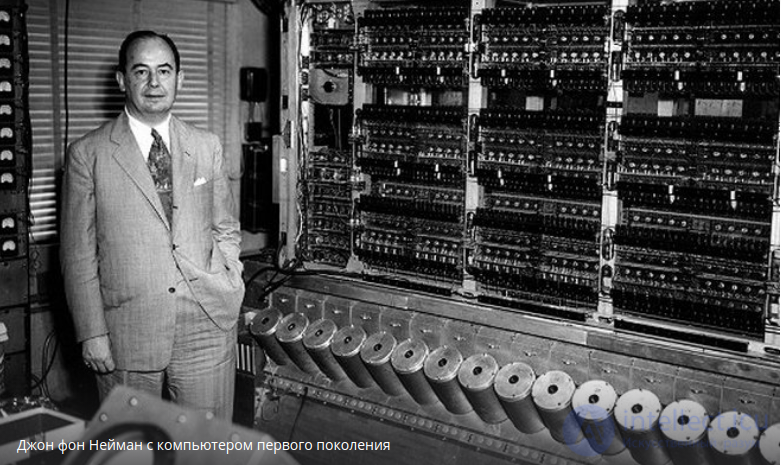
When Goldstein explained that the computer can perform 333 multiplications per minute, von Neumann excitedly asked for a more detailed explanation. “The whole atmosphere of our conversation,” recalled Goldstein, “has changed: from relaxing good humor to an atmosphere more similar to the oral exam for a doctorate in mathematics.” Von Neumann obtained permission from the authorities to visit the project. Arriving on September 7, 1944, at Moore’s electronic design school, where the computer was in the final stages, von Neumann gave the ENIAC program a respectability that did not arouse enthusiasm among the creators. John Mauchly, the author of the invention, considered von Neumann not the most eminent mathematician in the world and was excited that a figure of such magnitude showed interest in his work.
He was treated as a visiting member of the royal family, who was allowed to see everything and ask everything. What he saw was striking in its magnificence: two batteries that calculated at a speed that was much faster than the one with which von Neumann could calculate in mind. But feeling the enormous potential inside ENIAC, he already imagined more advanced computers that would even exceed these computational capabilities in their significance. According to Mauchli, von Neumann was so much like a child who received a new toy.
Neumann became a person firmly established in the ENIAC and EDVAC projects as a consultant, high-ranking visitor and enthusiast. He realized that the work of Mauchly and Eckert on the implementation of ENIAC and EDVAC projects are very important for science. Summarizing what he saw and heard about the ENIAC and EDVAC projects in June 1945, less than a year after he joined the Mauchly and Eckert groups, Neumann, using his high authority, wrote a report entitled “Preliminary Report on the EDVAC Machine”. In it, he described not only the machine itself, but also its logical organization.
It is interesting to present the main points of the report (cited under the article “Preliminary Consideration of the Logical Design of an Electronic Computing Device”, written and published a year later with A. Burks and G. Goldstein and repeating the content of the report):
“Since the completed device will be a universal computing machine, it must contain several basic organs, such as an organ of arithmetic, memory, control, and communication with the operator. We want the machine to be independent of the operator after the start of the calculations. ”
“Obviously, a machine must be able to memorize in some way not only the digital information necessary for a given calculation ... but also the commands that control the program that must perform calculations on this numerical data.”
“If, however, orders (commands) of a machine are reduced to a numerical code and if the machine can somehow distinguish a number from an order (command), then the memory organ can be used to store both numbers and orders (commands)” (the idea put forward in early 1944 by Eckert). “If the memory for orders (commands) is simply a memory organ, then there must be another organ that can automatically execute orders (commands) stored in memory. We will call this body the manager. ”
“Since our device must be a computer, it must have an arithmetic body ... a device that can add, subtract, multiply, and divide.”
“Finally, there must be an input and output authority through which communication between the operator and the machine is carried out.”
As mentioned in the previous essay, Hermann Goldstein replicated this report and sent it to scientists in the USA and England. For the first time, outsiders who are not working on EDVAC learned about an electronic computer project with a stored program. John von Neumann began to be perceived as the first initiator of the first computer project. This conclusion discouraged many valid developers. Mauchly and Eckert were angry at Goldstein for violating the secret rulings that had kept their own leading role in the EDVAC project from disclosing them. They were also enraged by the fact that Neumann allowed to put his name at work, without giving honor to the deserved contribution of Moore’s research team.
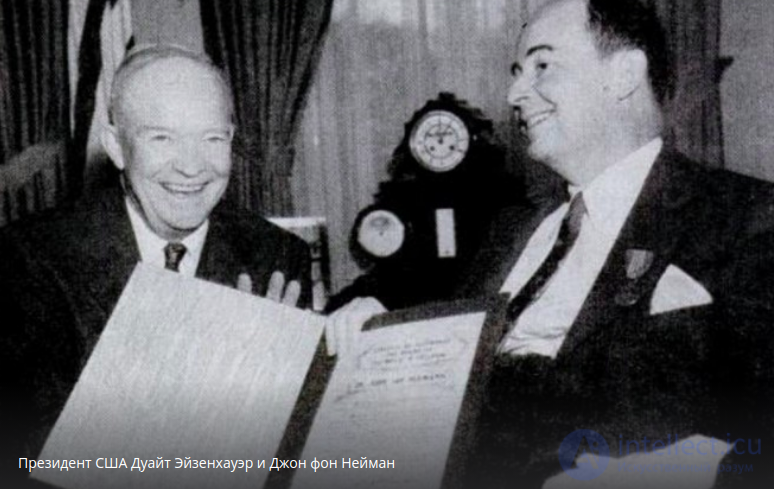
It must be said that years later, German Goldstein helped to give the necessary form to the myth of von Neumann's priority in this field of activity. “This is obvious,” he stated in his book “Computer from Pascal to von Neumann,” “that von Neumann, writing his report, gave some form of thinking in the field of computers, which no one else has done before. He was, among all the members of the group at Moore’s school, the most indispensable person ... only von Neumann was very valuable for the whole assignment. ” This opinion of Goldstein does not change the fact that Presper Eckert wrote a note about a computer with a stored program six months before von Neumann heard about the work carried out at Moore’s school.
EDVAC with 4,000 electron tubes and 10,000 crystal diodes, in the absence of Mauchly and Eckert, was completed only in 1952. But von Neumann's talents were multifaceted. In 1944, he and Oscar Morgenstern published the classic work “Game Theory and Economic Behavior,” in which they analyzed simple games like poker and tossing to demonstrate that the “most possible” game method exists and is mathematically conditioned. Their “game theory” could also be applicable to economic and social issues. Through this book, von Neumann and Morgenstern made the first step towards a general mathematical theory of economics.
After World War II, von Neumann was bombarded with prestigious academic offers, none of which he accepted. Norbert Wiener suggested that he become the head of the mathematics department. At the University of Chicago, there was talk of creating a new institute of applied mathematics, which will be led by von Neumann. But he was eager to create his own computer, and Princeton seemed to be the best place to carry out this intention.
But this path was not smooth. Members of the Advanced Research Institute felt that their establishment was an idyllic ivory tower and was not a place cluttered with unattractive machinery samples, but von Neumann had the experience necessary to go his own way. His plans were to create a fully automatic, digital universal electronic computer, the fastest. It was intended for scientific research, and not for the commercial market. The IAS computer, named after the Institute for Advanced Study, was launched in 1946 and completed five years later.
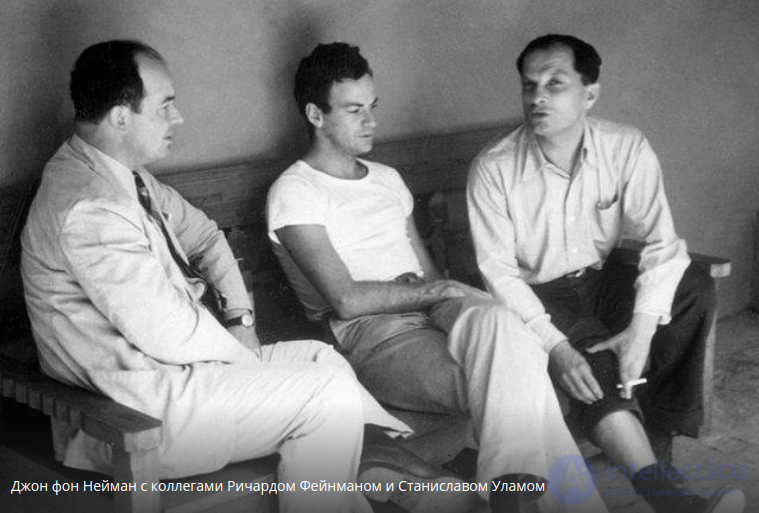
Meanwhile, on March 22, 1946, von Neumann and Goldstein tried to obtain a patent for EDVAC, justifying their claim on the “First Report”. They appealed to the Pentagon’s law office. On April 3, 1947, the army refused them, arguing that although the “First Report” qualifies as published evidence, it is already too late, because patents are granted within a year after the publication of the certificate. EDVAC had to become public property. Mauchly and Eckert were equally puzzled. They knew that the patent rightfully belonged to them.
In October 1954, von Neumann was appointed a member of the Atomic Energy Commission, which placed as its main concern the accumulation and development of nuclear weapons. It was approved by the United States Senate on March 15, 1955. In May, he and his wife moved to Washington, a suburb of Georgetown.During the last years of his life, von Neumann was the chief adviser on atomic energy, atomic weapons and intercontinental ballistic weapons. Perhaps due to his background or early experience in Hungary, von Neumann resolutely adhered to the right wing of political views. In an article in the journal “Life”, published on February 25, 1957, shortly after his death, he was presented with a supporter of a preventive war with the Soviet Union.
In the summer of 1954, von Neumann bruised his left shoulder during a fall. The pain did not go away, and the surgeons diagnosed a bone form of cancer. It was assumed that von Neumann’s cancer could have been triggered by his visits to nuclear weapons tests and his stay in Los Alamos for long months. The disease progressed and attending the AEC (Atomic Energy Commission) meetings three times a week required tremendous efforts.
He still remained a member of the CAA and a member of the scientific advisory board of the United States Air Force. When the scientist's end was close, the secretary of defense, the deputies, the secretaries of the land, sea and air forces and all the military chiefs of staff gathered around von Neumann's bed to meet at Walter Reed Hospital in Washington, DC - he was still important to them . Only physicians and orderlies could visit von Neumann for the purpose of a check on reliability, so great was the anxiety that, in a weakened state and under the influence of drugs, he could divulge secrets.
John von Neumann died on February 8, 1957. He will never know the full extent of his influence on computer science.
The merits of John von Neumann are widely recognized in many countries of the world. He was a member of the American Philosophical Society, the National Academy of Sciences, the American Academy of Arts and Sciences, the president of the American Mathematical Society. Neumann was also a corresponding member of many foreign academies, was awarded the medal for outstanding civil merit, Enrico Fermi and Albert Einstein prizes.
Comments
To leave a comment
Persons
Terms: Persons